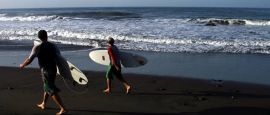El Salvador Weather, climate and geography
Weather & climate
El Salvador’s dry season (known locally as verano, or summer) runs between November and April, with a rainy season (invierno or winter) between May and October. In the rainy season, coastal and central regions typically suffer afternoon storms sandwiched between pleasant weather. In terms of temperature, the country’s subtropical climate can be divided into three separate zones, dependent on altitude. Coastal areas are uniformly hot throughout the year, the central plateau shows more extremes of hot and cold (though still rarely dropping below 10 °C) while upland areas have a cooler, more temperate climate. El Salvador is rarely affected by hurricanes, though tropical storm Agatha caused heavy rains and flooding in 2010.
For most travellers, it is best to visit during the dry season and to avoid the hottest time of the year (March-April) when humidity levels are particularly high. Surfers, however, should aim for April to October, or March at a push. In August beach and lake resorts are busy with Salvadoran holidaymakers.
Lightweight clothing and rainwear during the wet season in coastal areas. Waterproof clothing is advisable all year round. Warm clothing should be taken for higher altitudes. For camping and outdoor countryside activities, aim to cover up as much as possible to avoid potentially dangerous insect and animal bites.
Geography
El Salvador is situated in Central America between 13° and 14°N. It is bordered north and west by Guatemala, north and east by Honduras, and south and west by the Pacific Ocean. The country is the smallest in Central America and uniquely within the region, it has no Caribbean coastline.
North-easterly movement of the offshore Cocos tectonic plate and the westerly movement of El Salvador’s northern neighbours accounts for the frequency of earthquakes and volcanic activity in the country. Most of El Salvador is volcanic uplands, along which run two almost parallel volcanic ranges. The highest volcanoes are Santa Ana at 2,365m (7,759ft), San Vicente at 2,182m (7,159ft) and San Salvador at 1,943m (6,375ft). Volcanic activity has resulted in a thick layer of ash and lava on the highlands, creating a richly mineralised soil, ideal for coffee planting. Lowlands lie to the north and south of the high backbone.
On the country’s longest river, the Rio Lempa, the 800m (2,624ft)-wide hydroelectric Cerrón Grande Dam provides power to much of the country and has created a reservoir with capacity of 2,180 million m³. Fed by rivers in Guatemala and Honduras, the Lempa flows in a broadly southern direction spreading into the Bajo Lempa flood plain before draining into the Pacific.
Lago De Ilopango is the country’s largest ‘natural’ lake with surface area of 72 sq km (28 sq miles). A scenic crater lake with steeply scalloped banks, it lies just to the east of San Salvador. Of the country’s other lakes, Lago De Coatepeque is the most notable and perhaps most scenic with hot springs an added attraction for visitors. The lake covers 26 sq km (10 sq miles) in the province of Santa Ana, and like Ilopango it has steep high banks. Rising up from Coatepeque’s watery blue crater is Isla Teopán (‘sprouting island’) where important Mayan artefacts have been found.
Do you have any Feedback about this page?
© 2025 Columbus Travel Media Ltd. All rights reserved. No part of this site may be reproduced without our written permission, click here for information on Columbus Content Solutions.




 You know where
You know where